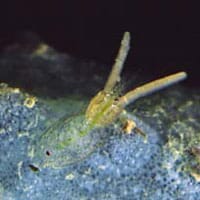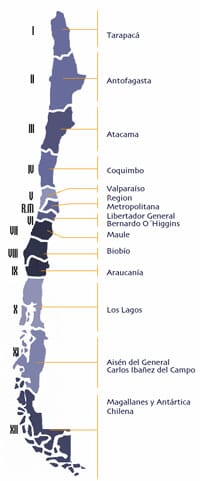The parasite is endemic and is located in the skin where it feeds from the mucus of the affected fish. It causes severe irritation to the fish and, in severe cases, causes loss of skin with consequent osmoregulation problems. Salmon producers are very concerned because the disease is severely affecting the farmed salmon populations in Chile’s Xth Region causing great economic losses.
 |
|
Maria-Jose Birrer
|
The agent is a crustacean (copepod). It affects native fish species and also the three major salmonid species farmed in Chile: Rainbow trout (Oncorhynchus mykiss), Coho salmon (Oncorhynchus kisutch) and Atlantic salmon (Salmo salar). Its life cycle consists of three planktonic stages , two nauplii and one copepodid which attaches by a frontal filament to the fish, four chalimus stages which are also attached to the fish and finally the adult stage which is mobile and feeds on the skin and mucus of the fish. After sexual maturity, females can be clearly distinguished from the males because they possess two long egg strings which contain approximately 75 eggs. This parasite does not survive salinities over 15 ppm and its growth is dependant on the water temperature. The complete life cycle takes 45 days at 10 ºC and 26 days at 15 ºC.
In 1981, the presence of Caligus teres affecting Coho salmon was first described in Chile. Some years later its presence was described in Rainbow trout. Then, in 1997, it is believed that because of a climatic phenomenon, the parasite Caligus rogercresseyi started to be reported in the region. This agent is the one that is now causing major losses to the Chilean salmon farming industry. Natural hosts for this parasite are native fish such us Patagonian blennie (Eleginops maclovinus), Silverside (Odontesthes regia) and Small-eye flounder (Paralichthys microps). The first two species play a major role in the transmission of the agent because they share the same marine habitat with the farmed salmonid species. Native fish maintain the pathogen in the environment.
 |
 |
| Los Lagos or region X in Chile is most severely affected |
The parasite provokes direct and indirect damage to the fish. When it feeds on the fish mucus it causes erosion and loss of scales; this produces a change in osmoregulation. The parasite causes irritation and increased jumping with a resultant decrease in feed intake. This situation makes the fish more susceptible to viral and bacterial diseases, causes a decrease in the growth and serious osmoregulation problems. Caligus may also play an important role as a vector for bacterial and viral diseases.
Initially the treatment of Caligiasis in Chile consisted of baths of pesticides (Triclorphon and Dichlorvos) which eliminated just the adult stages. Then, at the end of the eighties, Ivermectin, which was effective against every stage of the parasite, was used (orally administered), but because of it’s prolonged withdrawal period and toxicity it was replaced during the nineties with a similar fish-specific antiparasitic called emamectin benzoate.
After uninterrupted use of emamectin benzoate for several years and because of the high stocking density, the characteristics of the Xth Region interior waters, the absence of an integrated management programme and the use of just one treatment against Caligus, the parasite appear to have developed resistance against the drug.
Researchers believe that in order to minimize the impact of this disease, the most important step to take is to urgently develop new effective drugs against this parasite. Once the availability of at least three products is established, they should be rotated in order to avoid a new drug resistance problem.
An “all in - all out” system followed by a suitable fallow period and only a single generation or year class of fish within a production zone, together with synchronized and targeted treatments in all adjacent farms in a production area, will decrease the amount of Caligus larvae in the water column. Reducing the stress and supplementation of diets are measures which can help the fish to withstand this disease. This requires a lot of co-ordination, co-operation and communication between salmonid farms but it has been shown in other countries to be very effective in reducing the sea lice burden (see relevant abstracts in scientific summaries).

